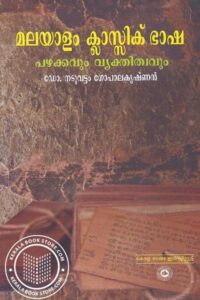
Dr. Naduvattom Gopalakrishnan
Publisher: Kerala Bhasha Institute, Thiruvananthapuram, 2019
Reviewed by: Dr. Vysakh Remesan (PhD, Indian Institute of Technology, HYI Visiting Fellow)
This book is a study in historical linguistics that traces the evolution of Malayalam, a Dravidian language spoken in Kerala, the southernmost state of the Indian subcontinent. Through this historical analysis, the author is making a strong case for giving Malayalam the status of a “Classic language”, an official status that the Government of India confers on certain Indian languages since 2004. As the name suggests, a classic language is expected to have a long-standing history, both as the spoken language of a community, as well as a literary language. Languages classified as “Classic” after being scrutinized by a national level committee receive socio-cultural veneration as well as financial support from the government, making the “Classic” status a highly sought after one. It is in this context that this book, which argues in favor of conferring a “Classic” status on Malayalam, gains relevance.
The primary concern of the work is to disentangle the complicated history of Tamil and Malayalam, two closely related Dravidian languages spoken in a geographically contiguous region separated by the mountains of Western Ghats. There have been multiple linguistic classifications that consider Malayalam to have originated from Tamil, which makes Tamil the more ancient of the two. This book refutes this claim by providing phonological, morphological and lexical evidence from ancient Indian texts and European travelogues. The author shows that Kerala, the region of Malayalam language, was a self-governed political entity that flourished in international trade, evidenced by multiple references to Kerala in these ancient texts. In this manner, the author reinforces the regionality of the language by reading references to the region as evidence of a linguistic legacy. The author also provides evidence from the differing phonologies of Malayalam and Tamil to further support this claim.
The author then moves on to the structural relations between Malayalam and other Dravidian languages such as Kannada and Tulu in order to show that Malayalam has also preserved several archaic lexical and morphological features, indicating a linguistic evolution independent of Tamil influence. This is further supported by several references to the language of Kerala as a “regional dialect” in Tamil literary texts written circa 8-9th century CE. Malayalam also boasts of its own texts written circa 13-14th century CE, that codified literary traditions such as manipravalam and leelathilakam.
Citing these evidence, the author makes a strong case for conferring the status of “Classic language” to Malayalam. The primary argument for this that Tamil and Malayalam evolved parallelly out of a Proto-Tamil-Malayalam that existed prior to 7th century CE. This produces a history in which the language and the region are inextricably linked, producing a unique cultural heritage that can claim an antique legacy.
While the arguments made by the author are persuasive, the potential consequences of producing a “Classic language” discourse should also be considered. One pitfall of the approach is the privileging of a particular variety of Malayalam as the “correct” code, which can marginalize many of the regional variations, found abundantly across the state of Kerala. Furthermore, at the national level, a focus on “Classic languages” can impact the already meagre institutional support provided to the numerous non-dominant and endangered languages across the subcontinent.
In conclusion, this book offers a comprehensive and engaging study of Malayalam’s evolution and its deep ties to the history and culture of Kerala. Whether for scholars of Dravidian languages, those interested in the dynamics of multilingualism, or readers concerned with the cultural politics of language, this work provides valuable insights into the complex and fascinating history of Malayalam.
